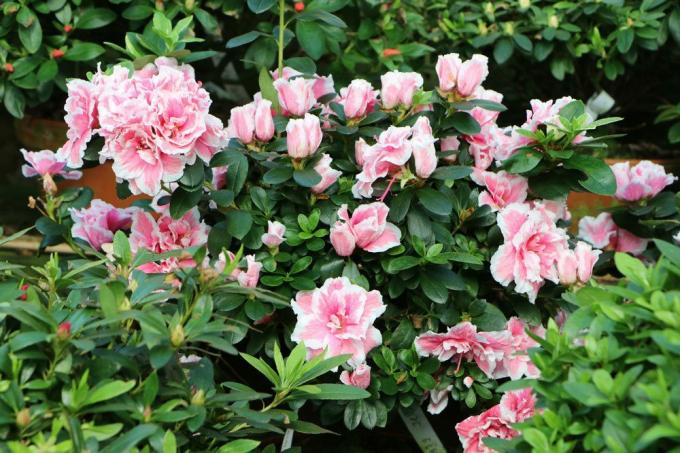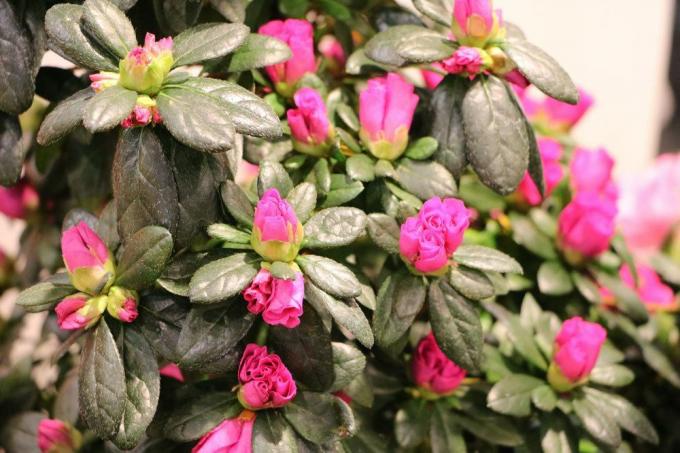
table of contents
- Is the azalea hardy?
- Garden azalea
- Hibernate garden azaleas in buckets
- Ideal location for lush flowering
- Indoor azaleas
- Hibernate an azalea?
The azalea impresses both as a houseplant and in the garden bed with a handsome flower. Its beauty is probably also due to the fact that in winter, when the other plants even shed their leaves, they bring color to the garden or apartment. After the flower has wilted, however, the plant looks a bit inconspicuous, almost bleak. This phenomenon causes many people to dispose of the plant early. This is not necessary at all. This guide shows whether the azalea is hardy and how plant lovers overwinter their room azaleas and preserve them for several years.
Is the azalea hardy?
Both with the garden azalea (Rhododendron molle or Rhododendron luteum) and the room azalea (Rhododendron simsii or Rhododendron japonicum) is a subspecies of the rhododendron. However, it would be a mistake to infer frost hardness from the origin.
Garden azalea
The garden azalea blooms in the warm season from May to June, in rare cases even in July. It comes from Europe and is therefore used to the local temperatures. The azalea is hardy down to -25 ° C. Therefore, garden azaleas need
no frost protection. The plant can usually be found as a hedge plant in private gardens. However, the azalea loses its leaves in winter.The situation is different with garden azaleas that the gardener cultivates in the tub. Since their roots cannot get to the groundwater and the frost makes it difficult to absorb moisture, they need these specimens provide winter protection, with the size of the bucket playing a major role in the wintering method plays:
Hibernate garden azaleas in buckets
Buckets with a diameter of <30 cm
- Stop fertilizer application from July
- move to frost-free winter quarters
- do not place too warm (ideally 3 to 10 ° C)
Buckets with diameters> 30 cm
- Stop fertilizer application from July
- relocate to a sheltered location (for example a house wall)
- Place the bucket on a block of wood or a styrofoam plate
- Wrap the bucket with fleece or foil
- Apply foliage or bark mulch to the substrate
Ideal location for lush flowering
Whether in the first or in the second year, so that azaleas wear lush flowers, the following location requirements must be met:
- cool temperatures (optimal are 8 ° C to 16 ° C)
- little sunlight
- no drafts
If the ornamental shrub is exposed to the wind, it pulls its sap back from the outer branches to protect it. This reduces the bloom formation enormously. In addition, strong sunlight leads to the wilting of the flowers and leaves. The pale light of the morning and evening sun is completely sufficient for the plant to carry out photosynthesis.
tip: The optimal location for indoor azaleas is the bedroom. This room is usually darkened and pleasantly cool.
Indoor azaleas
Maintain for several years: instructions
This azalea, however, is not hardy. But it impresses with its evergreen foliage and the bloom that shows up in the winter months from September to April. The indoor azalea comes from the tropics and therefore needs the following winter storage (important measures are explained in detail after the instructions):
- remove any remaining seeds
- Repot the azalea
- Place in a bright and cool place until May
- put outside after the ice saints
- Bring them into the house before the first night frosts
- place in a cool location
- do not place near the heater
- Regularly pluck withered flowers during the winter
- before the end of the growth phase cut back
Remove the remaining seeds
The remaining seeds in the substrate, like the indoor azalea, feed on nutrients from the soil. Thus, they rob the plant of important sources of energy for healthy growth and abundant flowering. The gardener should therefore remove them completely.
Put azalea outdoors
If the gardener puts the azalea in the fresh air, it is best to pot it out and place it in the bed. This should be in a shady, cool place with no drafts. The root ball needs constant moisture, but not waterlogging. After the temperatures drop in the first nights of September, if you carefully follow the instructions for wintering, a flower will also form in the following year.
Remove dead flowers
Like the seeds in the substrate, withered flowers rob the plant of valuable energy. Since brown discolored residues are not a pretty sight anyway, the gardener should check his plant regularly and pluck off dry leaves and flowers.
Cut back before the start of growth
As with many plants, pruning encourages the new growth of the indoor azalea after the rest break in winter.
Hibernate an azalea?
It is therefore possible to overwinter an azalea. However, the term is a bit misleading, as the shrub is primarily characterized by its ability to flower in winter. The real challenge lies more in the multi-year cultivation of the plant.
Important care note: The room azaleas come from the warm tropics and are not adapted to the European seasons. They open their buds in the dry season, which corresponds to the local winter. Therefore, only water the flowering shrub when the substrate is visibly dry. Only use rainwater (also condensation water if you like) or decalcified tap water for the water supply. Although the flower opens, the plant is dormant in winter. No fertilizer is required at this time.
Winter hardy varieties
The following azalea varieties are hardy and are therefore suitable for year-round outdoor use:
- Gibraltar (Rhododendron luteum): flowers from May to June in bright orange, height: 110 to 150 cm
- Snow gold (Rhododendron luteum): flowers from May to June, grows 110 to 150 cm high and is ideal for the balcony
- Rococo (Rhododendron obtusum): flowering time also from May to June, comes from Japan and has impressively wavy flower edges, with a stature height of 30 to 40 cm rather small


